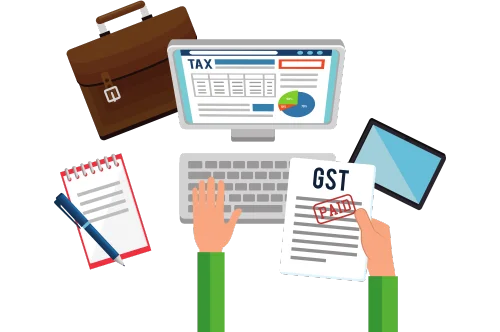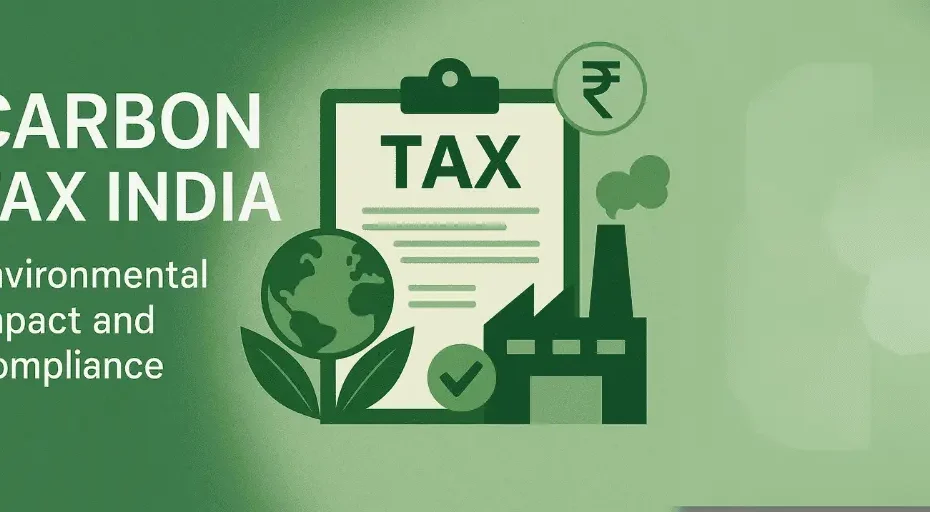Green Taxation in India: Environmental Impact and Compliance
In recent years, climate change has emerged as one of the most critical challenges facing the world. Nations are exploring fiscal tools to combat environmental degradation and reduce carbon emissions. Among these, carbon tax India has gained significant relevance. Green taxation, which includes instruments like carbon tax, environmental levies, and subsidies for sustainable practices, is increasingly being viewed as an effective way to steer India’s economy toward sustainability.
This blog explores how carbon tax India plays a pivotal role in the country’s environmental strategy, its economic impact, and how businesses can comply with emerging green tax norms.
Understanding Green Taxation
Green taxation refers to a fiscal approach where taxes are levied on activities and products that are harmful to the environment. These taxes aim to internalize the environmental costs of pollution and encourage sustainable practices among businesses and individuals. The logic is simple: polluters should pay for the damage they cause to the environment.
India has gradually begun integrating green taxation into its fiscal policy framework. Although still evolving, several levies—such as coal cess, vehicle pollution tax, and plastic usage charges—are already being implemented across different states.
One of the most impactful tools in this framework is the carbon tax India, which places a monetary cost on greenhouse gas emissions.
What is Carbon Tax?
A carbon tax is a price put on carbon emissions. It is levied on fossil fuels like coal, oil, and natural gas based on their carbon content. The idea is to make carbon-intensive goods and services more expensive, thus discouraging their use and incentivizing greener alternatives.
In the context of carbon tax India, this policy aims to:
Reduce carbon dioxide and other greenhouse gas emissions
Encourage industries to adopt clean technology
Generate revenue that can be reinvested in environmental and renewable energy initiatives
While many countries have implemented direct carbon taxes, carbon tax India is currently implemented more through indirect mechanisms like cess and duties.
Existing Carbon Tax Framework in India
India has not implemented a direct, nationwide carbon tax yet. However, it does employ several indirect carbon taxes. These include:
1. Coal Cess (Clean Energy Cess)
Introduced in 2010, the coal cess initially taxed domestically produced and imported coal at ₹50 per tonne, which was later increased to ₹400 per tonne. This cess functions similarly to a carbon tax India as it targets one of the most carbon-intensive fuels.
2. Excise Duty on Fuel
India imposes heavy excise duties on petrol and diesel. Though not labeled as a carbon tax, these duties serve a similar purpose—discouraging fossil fuel use and promoting energy conservation.
3. Pollution Tax on Vehicles
Vehicles in India are subject to the Green Cess, especially diesel-run vehicles, which are more polluting. These taxes reflect the principles of carbon tax India, targeting emissions at the point of use.
Why Carbon Tax India Matters
There are several compelling reasons why implementing a structured carbon tax India could be a game-changer for both the environment and the economy:
✔ 1. Drives Cleaner Industry Practices
By increasing the cost of pollution, carbon tax India would motivate companies to shift toward cleaner fuels, improve energy efficiency, and invest in low-carbon technologies.
✔ 2. Generates Green Revenue
The tax collected can be earmarked for climate adaptation programs, renewable energy projects, and environmental restoration.
✔ 3. Supports Global Climate Commitments
India has pledged to achieve net-zero emissions by 2070. A robust carbon tax India policy would be instrumental in meeting this target by reducing emissions across key sectors.
✔ 4. Encourages Behavioral Change
Consumers and businesses tend to make environmentally conscious choices when they see a direct financial impact. Carbon tax serves as a price signal pushing the economy toward sustainability.
Challenges to Implementing Carbon Tax in India
Despite the clear benefits, the implementation of a nationwide carbon tax India faces several hurdles:
1. Economic Burden on Lower-Income Groups
Since fuel and energy are essential goods, a carbon tax could disproportionately affect lower-income households unless subsidies or compensation measures are put in place.
2. Industrial Pushback
Industries that rely heavily on fossil fuels may resist the move, citing increased operational costs and loss of competitiveness.
3. Lack of Administrative Infrastructure
Effective monitoring, reporting, and verification (MRV) mechanisms are essential for carbon taxation to work. Currently, India lacks a robust MRV system for carbon emissions.
4. Overlap with Other Environmental Policies
India is also working on carbon trading systems and renewable energy subsidies. Poor alignment between these policies and carbon tax India could result in inefficiencies.
Compliance and Regulatory Landscape
For businesses and industries, compliance with green tax regulations, including the principles of carbon tax India, involves:
Measuring Carbon Footprint: Organizations need to calculate their total emissions accurately.
Adopting Cleaner Technologies: Energy-efficient machinery, process innovation, and renewable energy adoption reduce tax liability.
Maintaining Proper Records: Accurate documentation helps in tax calculations and audits.
Participating in Sustainability Disclosures: Environmental, Social, and Governance (ESG) reporting is becoming increasingly essential.
As the government develops a formal structure for carbon tax India, staying ahead on compliance will offer both reputational and financial benefits.
Global Lessons for India
Countries like Sweden, Canada, and the UK have successfully implemented carbon taxes. Sweden’s carbon tax, for instance, is one of the highest globally but has coincided with strong GDP growth and declining emissions. India can draw several lessons:
Set realistic carbon prices based on economic capacity
Use tax revenue for climate mitigation programs
Gradually phase in the tax to give industries time to adapt
Provide subsidies or rebates to shield vulnerable populations
Learning from these international experiences can ensure the effective rollout of carbon tax India.
The Future of Carbon Tax India
India’s environmental policy landscape is evolving rapidly. The push for a domestic carbon market, new emissions trading schemes, and expanding renewable energy are clear signs of a green transition. A formal carbon tax India policy, if well-designed, can complement these efforts.
Some steps that could solidify India’s carbon tax future include:
Launching a direct carbon tax on major polluting industries
Aligning carbon tax rates with global carbon pricing benchmarks
Incorporating carbon tax into GST framework for ease of implementation
Establishing a transparent carbon registry for public tracking
Conclusion
Green taxation is no longer a concept of the future—it is a necessity of the present. While India has taken several steps toward environmental accountability through indirect levies, the time has come to formalize a comprehensive carbon tax India framework.
By pricing pollution, promoting clean technologies, and encouraging behavioral change, carbon tax India could play a crucial role in steering the nation toward its climate goals. With the right balance of regulation, incentives, and public participation, India can lead the way in sustainable growth and environmental stewardship.
Our GST Services

All E-commerce Tax services
E-commerce tax services help online sellers navigate GST registration, compliance, return filing, TCS management, tax planning, and audits, ensuring efficient tax management and legal compliance.

GST Filing
GST filing is the process of submitting tax returns to the government, detailing sales, purchases, and taxes paid or collected, ensuring compliance with GST laws.

GST Registration
GST registration is the process where businesses obtain a GSTIN from the government, allowing them to collect taxes, claim input tax credits, and comply with GST laws.





